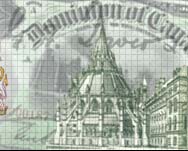|

1935 Series Notes
When the Bank of Canada opened for business on March 11, 1935, it issued its own notes in denominations of $1, $2, $5, $10, $20, $50, $100, $500 and $1000. These notes were significantly smaller than previous Dominion of Canada issues and are approximately the same size as modern banknotes.
The 1935 Series of banknotes is the first and only series to have two separate notes per denomination, one for each of Canada's official languages. As might be expected, most of the French notes were sent to the Bank of Canada agency in Montreal, although most other agencies received a small amount of French notes as well.
The $1 note features His Majesty King George V on the face of the note and the reverse shows an agriculture allegory: a seated female with agricultural tools and produce.
There was a total printing of over 75,000,000 1935 $1 notes released into circulation. |

© Bank of Canada - used with permission

© Bank of Canada - used with permission |

© Bank of Canada - used with permission

© Bank of Canada - used with permission |
The $2 note has a portrait of Queen Mary on the front and a transportation allegory on the reverse. This design shows a standing Mercury with ships, trains and planes.
Almost 28,000,000 $2 notes were issued for circulation, only 5,300,000 of them French. |
The Prince of Wales and future King Edward VIII appears on the face of the $5 note. Within a year of his coronation, he abdicated the throne to his brother, the Duke of York, who reigned as King George VI. The reverse shows an electric power allegory with a seated male and symbols of electricity.
Slightly more than 9,000,000 1935 $5 notes were printed. |

© Bank of Canada - used with permission

© Bank of Canada - used with permission |

© Bank of Canada - used with permission

© Bank of Canada - used with permission |
Princess Mary made an appearance as the portrait on the front of the 1935 $10 note. The reverse of the $10 note shows a harvest allegory featuring a seated female with fruits of harvest.
Barely 6,500,000 1935 $10 notes were issued before the 1937 series was released. |
The 1935 $20 note sets a precedent in that it is the first and only banknote issued by the Canadian government to feature a minor, in this case being the young Princess Elizabeth, later to become Queen Elizabeth II in 1953. The $20 note is a common favourite of the 1935 series because the portrait of Princess Elizabeth is often compared to Shirley Temple. The bright pink reverse of the $20 note includes an agriculture allegory with a kneeling male presenting the produce of the field to a female agricultural figure.
The $20 note is also the only denomination to have two different sized seals for the Bank of Canada. Initially, the note featured a large seal as on the $1, $2, $5 and $10 denominations, but at approximately A050000, the Bank began using the small seals from the higher denominations. In total, approximately 1,200,000 $20 notes were issued. |

© Bank of Canada - used with permission

© Bank of Canada - used with permission |

© Bank of Canada - used with permission

© Bank of Canada - used with permission |
The $50 note features Prince Albert, Duke of York, who later became King George VI after his brother, the King Edward VIII abdicated the throne in December, 1936. The theme of the allegory on the reverse of this note is modern inventions and shows a seated female with symbols of radio broadcasting.
Approximately 163,000 $50 notes were issued for circulation across Canada. This denomination is quite rare and ranges in value from $600 to $14,000, depending on condition. |
The portrait on the $100 note is that of Prince Henry, the Duke of Gloucester. Commerce and industry is the theme on the reverse of the $100 note and it shows a seated male showing a ship to a child, with a dock and industrial scene in the background.
Despite having a lower quantity of notes printed (105,000), the $100 notes are slightly less rare than the $50 notes. |

© Bank of Canada - used with permission

© Bank of Canada - used with permission |

© Bank of Canada - used with permission

© Bank of Canada - used with permission |
Sir John A. Macdonald, the first prime minister of Canada, appears on the $500 note. The $500 note has a fertility allegory on the reverse, showing a seated female with a sickle.
With almost 26,000 notes issued, the $500 note is the scarcest of all 1935 series banknotes. In fact, as of 2001, only 42 $500 notes were still outstanding. Most are presumed destroyed by fire or decay. These notes are so scarce today that prices have not been determined for the French version or high-grade English notes. Mid-grade English notes sell for upwards of $30,000 each. The $500 denomination was permanently discontinued after the 1935 series. |
Sir Wilfrid Laurier is the subject of the portrait on the $1,000 note. The allegory on the reverse of the $1,000 note is of security and shows a kneeling female shielding her child.
The 1935 $1,000 notes enjoyed the longest lifespan of any 1935 series note. Stocks of these notes had not run out until January, 1952. These notes were used primarily by chartered banks as an economical means of storing large amounts of cash. Just more than 74,000 $1,000 notes were printed and issued. |

© Bank of Canada - used with permission

© Bank of Canada - used with permission |
Contributor: Anonymous
[ Back ]
|



